Restek's PLOT Column Family
The Benchmark For Performance!
- Innovative bonding process minimizes particle release.
- More consistent flow means stable retention times.
- Outstanding peak symmetry improves impurity analysis.
| Model your PLOT column using our Pro EZGC Chromatogram Modeler |
Next Generation of Porous Layer Open Tubular (PLOT) Columns
- Stabilized particle layers improve robustness and reproducibility of retention and flow.
- Highly efficient, reproducible analyses; ideal for permanent gases, solvents, and hydrocarbons.
- Innovative manufacturing procedure reduces particle generation and improves performance of PLOT columns.
- Wound on a 7"-diameter, 11-pin cage unless otherwise noted.
Porous layer open tubular (PLOT) columns are very beneficial for solving application problems, especially for the analysis of volatile compounds. PLOT columns have a unique selectivity, allowing for the separation of volatile compounds at ambient temperature. Due to the adsorption mechanism of the stationary phases used in PLOT columns, permanent gases and light hydrocarbons can be resolved at ambient temperature; columns can then be programmed to higher temperatures to elute higher boiling compounds.
Traditional PLOT Columns Offer Poor Stability
The traditional PLOT column is built with a 5–50 μm layer of particles adhered to the tubing walls. Because this layer of particles generally lacks stability, PLOT columns must be used very carefully as particle release is common and can cause unpredictable changes in retention time and flow behavior. Traditional PLOT columns also must generally be used in conjunction with particle traps to prevent the contamination of valves, injectors, and GC detectors. Detectors contaminated with particles typically generate electronic noise, which shows up chromatographically as a spike in the baseline. In extreme cases, detector flow can be obstructed by particle buildup. Particles can also affect valves by becoming lodged in the valve and causing leaks or restricting flow. Figure 1 shows an example of blockage caused by particle accumulation inside a Press-Tight connector.
Figure 1: Particles released from traditional PLOT columns can cause blockages.
Restek PLOT Columns Offer Improved Stability to Minimize Particle Release
Restek has developed technology and procedures to manufacture PLOT columns with concentric stabilized adsorption layers. These next generation PLOT columns show a constant flow behavior (permeability) and have significantly improved mechanical stability, resulting in easier operation, better chromatography, and reduced particle release.* Greater particle stability means more reproducible retention times, virtually no spiking, and longer column lifetimes. This innovative Restek stabilization chemistry is currently applied to all fused silica and metal PLOT columns featured here.
*A particle trap is still recommended to protect valves and detectors.
Consistent Flow Restriction Factor (F) Guarantees Reproducible Flow
Thick layers of particles are difficult to deposit in a homogeneous layer, and in traditionally manufactured PLOT columns, this results in variable coating thicknesses. The positions where the layer is thicker act as restrictions and affect flow (Figure 2). Depending on the number and intensity of these restrictions, traditional PLOT columns often show greater variation in flow restriction than wall coated open tubular (WCOT) columns. In practice, conventional PLOT columns with the same dimensions can differ in flow by a factor of 4 to 6 when operated at the same nominal pressure. For applications where flow is important, such as with Deans switching, the nonreproducible flow behavior of most commercially available PLOT columns is a problem.
Figure 2: Inconsistent coating thicknesses result in restrictions that cause significant variation in flow.
In order to measure flow restriction reproducibility, Restek introduced a new factor: the flow restriction factor (F). This factor is based on the retention time of an unretained marker compound as measured on both coated and uncoated tubing using the same back pressure setting (Equation 1). For quality control purposes, methane is used as the marker when evaluating porous polymer columns, and helium is used for testing molecular sieve 5A columns.
Flow restriction factor determination can be used to assess both the degree of column restriction and the reproducibility of the column coating process. Figure 3 shows typical results for PLOT columns manufactured using a conventional process. Because of the difference in flow restriction, individual columns have very different flow characteristics. In contrast, Figure 4 shows results for columns made using our Rt-QS-BOND (bonded porous polymer) PLOT column process. Clearly, our manufacturing process results in greater consistency in both column coating thickness and flow restriction, which results in more stable retention times and better performance in Deans and related flow switching techniques. Flow restriction factors are specified on the certificate of analysis (CofA) included with every Restek PLOT column, and the values are listed on the report.
Figure 3: Traditional PLOT columns show significant flow variability, indicating inconsistent column coating thicknesses.
Equation 1: Flow restriction factor (F) is used to demonstrate coating consistency.
Note: F values will always be <1 as the coated column always has more restriction than the uncoated column.
Figure 4: PLOT columns from Restek offer consistent flow restriction, giving more reproducible results column to column.
Restek’s PLOT columns are exceptionally robust, featuring concentric stabilized coating layers. They allow for more consistent gas flows and are recommended for applications sensitive to variation in retention time or flow. These PLOT columns are a significant advance in technology and are ideal for efficient, reproducible analyses of permanent gases, solvents, and hydrocarbons.
PLOT Column Phase Cross-Reference: Similar Selectivity
|
Restek Rt and MXT Columns |
Porous Layer |
Supelco |
Alltech |
Agilent (J&W, Varian, Chrompack) |
Quadrex |
|---|---|---|---|---|---|
|
Aluminum oxide |
Alumina-Sulfate |
AT-Alumina |
GS-Alumina, CP-Al2O3/NA2SO4 |
— |
|
|
Aluminum oxide |
Alumina-Chloride |
— |
GS-Alumina KCl, HP PLOT Al2O3, CP-Al2O3/KCl |
— |
|
|
Aluminum oxide |
unique product | ||||
|
Aluminum oxide |
— |
— |
Select Al2O3 MAPD |
— |
|
|
Molecular sieve 5A |
Molsieve 5A |
AT-Molesieve |
HP PLOT Molesieve, |
PLT-5A |
|
|
100% Divinylbenzene |
Supel-Q-PLOT |
AT-Q |
HP PLOT Q ,CP-PoraPlot Q, PoraBond Q |
— |
|
|
Intermediate polarity porous polymer |
— |
— |
GS-Q |
— |
|
|
DVB vinylpyridine polymer |
— |
— |
CP-PoraPlot S |
— |
|
|
DVB ethylene glycoldimethylacrylate polymer |
— |
— |
HP PLOT U, CP-PoraPlot U, CP-PoraBond U |
— |
|
*Available only with fused silica tubing.
Rt-Alumina BOND Columns
Restek Rt-Alumina BOND columns are highly selective for C1–C5 hydrocarbons and separate all saturated and unsaturated hydrocarbon isomers above ambient temperatures. The reactivity of the aluminum oxide stationary phase is minimized, by deactivation with inorganic salts like KCl or Na2SO4, to improve column response for polar unsaturates, such as dienes, and the column's sensitivity (or response) ensures linear and quantitative chromatographic analysis for these compounds. Strong bonding minimizes particle generation and release, which allows valve switching with minimal risk to the injection or detection systems. And because they are stable up to at least 200 °C, Rt-Alumina BOND columns can be regenerated to restore full efficiency and selectivity by conditioning at their maximum temperature if water is adsorbed. High capacity and loadability give you exceptionally symmetrical peaks, making these columns ideal for volatile hydrocarbon separations at percent levels, as well as impurity analyses at ppm concentrations. Restek Rt-Alumina BOND PLOT columns are manufactured on fused silica tubing; select phases are also available on metal MXT tubing.
To ensure reproducible retention times and predictable flow behavior column to column, each Rt-Alumina BOND column is extensively tested. A hydrocarbon test mix confirms proper phase retention and selectivity. To calculate k (retention or capacity factor), which is a measure of phase retention, 1,3-butadiene is used, while selectivity is measured using retention indices for propadiene and methyl acetylene. The resolution of trans-2-butene and 1-butene is also verified and, to measure efficiency, plates per meter are checked using 1,3-butadiene.
Rt-Alumina BOND/Na2SO4 Columns (fused silica PLOT)
(Na2SO4 deactivation)
- Acetylene and propadiene elute after butanes.
- Best separation for butene isomers (impurities in butene streams).
- Methyl acetylene elutes after 1,3-butadiene.
- Cyclopropane (impurity in propylene) elutes well before propylene.
- Stable to 200 °C.
- Also available on metal MXT tubing!
Refinery Gas on Rt-Alumina BOND (Na2SO4)

| Peaks | |
|---|---|
| 1. | Methane |
| 2. | Ethane |
| 3. | Ethylene |
| 4. | Propane |
| 5. | Propylene |
| 6. | Isobutane |
| 7. | n-Butane |
| 8. | Propadiene |
| 9. | Acetylene |
| 10. | trans-2-Butene |
| Peaks | |
|---|---|
| 11. | 1-Butene |
| 12. | Isobutylene |
| 13. | cis-2-Butene |
| 14. | iso-Pentane |
| 15. | n-Pentane |
| 16. | 1,3-Butadiene |
| 17. | trans-2-Pentene |
| 18. | 2-Methyl-2-butene |
| 19. | 1-Pentene |
| 20. | cis-2-Pentene |
| 21. | Hexanes |
| Column | Rt-Alumina BOND/Na2SO4, 50 m, 0.53 mm ID, 10 µm (cat.# 19756) |
|---|---|
| Standard/Sample | Refinery gas |
| Injection | |
| Inj. Vol.: | 10 µL split |
| Liner: | Taper (2 mm) |
| Inj. Temp.: | 200 °C |
| Split Vent Flow Rate: | 80 ml/min. |
| Oven | |
| Oven Temp.: | 45 °C (hold 1 min) to 200 °C at 10 °C/min (hold 3.5 min) |
| Carrier Gas | H2, constant pressure (8.0 psi, 55.2 kPa) |
| Linear Velocity: | 74 cm/sec @ 45 °C |
| Detector | FID @ 200 °C |
|---|---|
| Notes | Liner cat.# 20795 was used to produce this chromatogram, but has since been discontinued. For assistance choosing a replacement for this application, contact Restek Technical Service or your local Restek representative. |
Rt-Alumina BOND/KCl Columns (fused silica PLOT)
(KCl deactivation)
- Restek's lowest polarity alumina column.
- Low moisture sensitivity reduces the need for frequent regeneration.
- Acetylene elutes before n-butane.
- Methyl acetylene (impurity in 1,3-butadiene) elutes before 1,3-butadiene.
- Stable to 200 °C.
Ethylene and C1-C5 Hydrocarbons by ASTM D6159-97 on Rt-Alumina BOND/KCl, Rtx-1

| Peaks | |
|---|---|
| 1. | Methane |
| 2. | Ethane |
| 3. | Ethylene |
| 4. | Propane |
| 5. | Cyclopropane |
| 6. | Propylene |
| 7. | Acetylene |
| 8. | Isobutane |
| 9. | Propadiene |
| Peaks | |
|---|---|
| 10. | n-Butane |
| 11. | trans-2-Butene |
| 12. | 1-Butene |
| 13. | Isobutylene |
| 14. | cis-2-Butene |
| 15. | iso-Pentane |
| 16. | Methylacetylene |
| 17. | n-Pentane |
| 18. | 1,3-Butadiene |
| Column | Rt-Alumina BOND/KCl *, 50 m, 0.53 mm ID, 10 µm (cat.# 19760) |
|---|---|
| Standard/Sample | Ethylene gas plus C1 through C5 hydrocarbons |
| Injection | |
| Inj. Vol.: | 1 µL split |
| Liner: | 2 mm splitless |
| Inj. Temp.: | 200 °C |
| Split Vent Flow Rate: | 60 ml/min. |
| Oven | |
| Oven Temp.: | 35 °C (hold 2 min) to 190 °C at 4 °C/min (hold 15 min) |
| Carrier Gas | He, constant pressure (8.0 psi, 55.2 kPa) |
| Linear Velocity: | 25.4 cm/sec @ 35 °C |
| Detector | FID @ 200 °C |
|---|---|
| Make-up Gas Type: | N2 |
| Data Rate: | 20 Hz |
| Instrument | HP5890 GC |
| Notes | GC liner cat.# 20712 was used to produce this chromatogram, but it has since been discontinued. For assistance choosing a liner for this application, contact Restek Technical Service or your local Restek representative. * Rt-Alumina BOND/KCl, 50 m, 0.53 mm ID, 10.0 μm (cat.# 19760) in series with an Rtx-1, 30 m, 0.53 mm ID, 5.0 μm (cat.# 10179) connected using a universal Press-Tight connector (cat. # 20401). (conditions as per ASTM D6159-97) |
Rt-Alumina BOND/CFC Columns (fused silica PLOT)
- Improved inertness for chlorofluorocarbon (CFC) compounds.
- Highly selective alumina-based column, separates most CFCs.
- High retention and capacity for CFCs.
- Stable to 200 °C.
The Alumina BOND/CFC adsorbent is ideal for retaining volatile halogenated compounds, especially CFCs (chlorinated fluorocarbons) like Freon products. It offers high selectivity, allowing a wide range of CFC isomers to be resolved at above ambient temperatures. The Rt-Alumina BOND/CFC column is thoroughly deactivated to reduce the reactivity of alumina. Even though there is still some residual reactivity for some mono- or disubstituted CFCs, the majority of these compounds can be accurately quantified from main stream processes or in impurity analyses.
Impurity Analysis of 1,1,1,2-Tetrafluoroethane (CFC-134a) on Rt-Alumina BOND/CFC
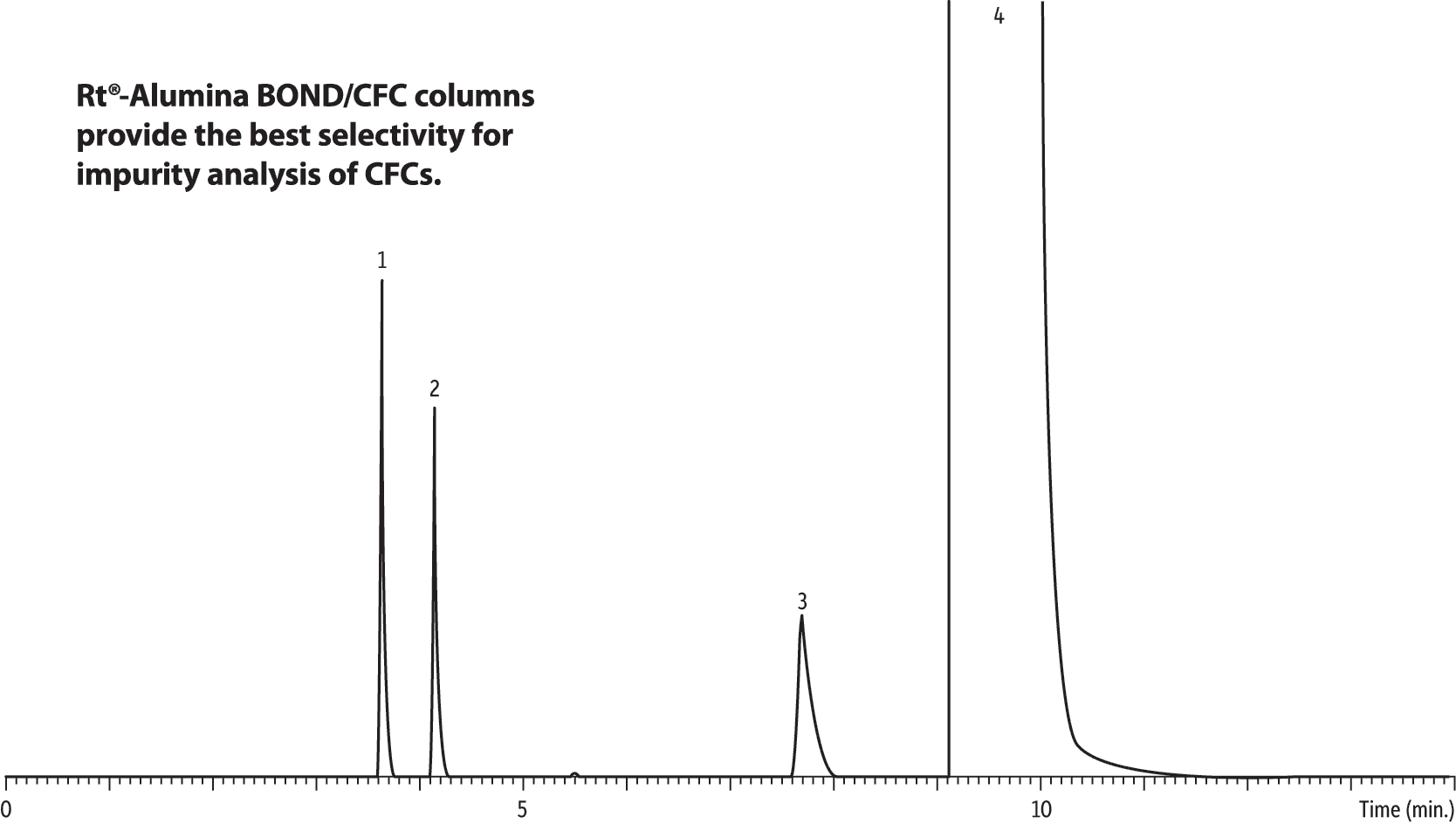
| Peaks | |
|---|---|
| 1. | Chloropentafluoroethane (CFC-115) |
| 2. | Dichlorodifluoromethane (CFC-12) |
| 3. | Chlorodifluoromethane (CFC-22) |
| 4. | 1,1,1,2-Tetrafluoroethane (CFC-134a) |
| Column | Rt-Alumina BOND/CFC, 30 m, 0.53 mm ID (cat.# 19763) |
|---|---|
| Standard/Sample | 1,1,1,2-Tetrafluoroethane |
| Conc.: | Neat |
| Injection | |
| Inj. Vol.: | 500 µL split |
| Oven | |
| Oven Temp.: | 80 °C (hold 6 min) to 140 °C at 10 °C/min (hold 2 min) |
| Carrier Gas | He |
| Detector | FID |
|---|---|
| Notes | Gas sampling, purity analysis Note that tailing peaks are common in CFC analyses due to overloading normally employed for this type of work. |
Rt-Alumina BOND/MAPD Columns (fused silica PLOT)
- Optimized deactivation produces maximum response when analyzing trace levels of acetylene, methyl acetylene, and propadiene.
- Stable response factors make this column ideal for process-type applications where recalibration must be minimized.
- High loadability reduces peak tailing and improves separations.
- Extended temperature range up to 250 °C for fast elution of high molecular weight (HMW) hydrocarbons and accelerated column regeneration following exposure to water.
- Stable to 250 °C.
- Also available on metal MXT tubing!
Restek's R&D chemists have optimized the deactivation technology applied to our Rt-Alumina BOND/MAPD column for improved analysis of trace concentrations of polar hydrocarbons like acetylene, methyl acetylene, and propadiene in hydrocarbon streams containing higher levels of C1-C5 hydrocarbons. Our alumina PLOT deactivation produces an incredibly inert column that offers superior reproducibility and stable response factors to maximize the number of analyses before recalibration is required. Its high sample capacity reduces peak tailing, thereby improving the separation of target compounds. In addition, a 250 °C maximum operating temperature lets you more quickly elute hydrocarbons up to dodecane and reduces regeneration time when the column is exposed to water from samples or carrier gases.
1,3-Butadiene on Rt-Alumina BOND/MAPD (Purity Analysis)

| Peaks | |
|---|---|
| 1. | Isobutane |
| 2. | n-Butane |
| 3. | Propadiene |
| 4. | trans-2-Butene |
| 5. | 1-Butene |
| 6. | Isobutene |
| Peaks | |
|---|---|
| 7. | cis-2-Butene |
| 8. | Isopentane |
| 9. | n-Pentane |
| 10. | 1,2-Butadiene |
| 11. | 1,3-Butadiene |
| 12. | Methyl acetylene |
| Column | Rt-Alumina BOND/MAPD, 50 m, 0.53 mm ID, 10.0 µm (cat.# 19778) |
|---|---|
| Standard/Sample | Crude 1,3-butadiene |
| Injection | |
| Inj. Vol.: | 10 µL split |
| Liner: | 2.0 mm ID straight inlet liner |
| Inj. Temp.: | 200 °C |
| Split Vent Flow Rate: | 100 mL/min. |
| Oven | |
| Oven Temp.: | 70 °C (hold 5 min) to 200 °C at 10 °C/min (hold 0 min) |
| Carrier Gas | He, constant pressure (20 psi, 137.9 kPa) |
| Detector | FID @ 250 °C |
|---|---|
| Make-up Gas Flow Rate: | 30 mL/min |
| Make-up Gas Type: | N2 |
| Data Rate: | 20 Hz |
| Instrument | HP5890 GC |
| Notes | GC liner cat.# 20712 was used to produce this chromatogram, but it has since been discontinued. For assistance choosing a liner for this application, contact Restek Technical Service or your local Restek representative. |
Molecular Sieve 5A PLOT Columns
Restek’s molecular sieve 5A PLOT columns are designed for efficient separation of argon/oxygen and other permanent gases, including carbon monoxide. Special coating and deactivation procedures ensure chromatographic efficiency and the integrity of the porous layer coating. Molecular sieves have very high retention, allowing separations of permanent gases at temperatures above ambient. Our deactivation technology also allows carbon monoxide to elute as a sharp peak. Additionally, our unique immobilization process guarantees that the uniform particles remain adhered to the tubing—even after continuous valve cycling.
Rt-Msieve 5A Columns (fused silica PLOT)
- Improve accuracy with sharp, symmetrical peaks for argon, oxygen, and carbon monoxide.
- Easily separate permanent gases at temperatures above ambient.
- Restek PLOT technology reduces particle release, improving flow reproducibility and reducing downtime for maintenance.
- Stable to 300 °C.
- Also available on metal MXT tubing!
Separation of Argon/Oxygen and Other Permanent Gases on Rt-Msieve 5A

| Column | Rt-Msieve 5A, 30 m, 0.53 mm ID, 50 µm (cat.# 19723) |
|---|---|
| Standard/Sample | Permanent gases |
| Injection | sample valve |
| Sample Loop Vol.: | 5 µL |
| Valve Name: | 6-port Valco valve |
| Inj. Temp.: | 200 °C |
| Valve Temp.: | Ambient °C |
| Oven | |
| Oven Temp.: | 27 °C (hold 5 min) to 100 °C at 10 °C/min (hold 5 min) |
| Carrier Gas | He, constant flow |
| Flow Rate: | 5.0 mL/min |
| Detector | Valco helium ionization detector @ 150 °C |
|---|
Porous Polymer Columns
Porous polymers are unique, highly retentive stationary phases with a wide application range that are able to elute both polar and nonpolar compounds. They are very hydrophobic, so water has no impact on retention times and even elutes as a good chromatographic peak. The Q-BOND is our most nonpolar and widely used porous polymer column; functional groups can be added to increase polarity (i.e., QS-, S-, and U-BOND). The process used to manufacture porous polymer PLOT columns causes the particles to adhere strongly to the walls of the tubing, so there is virtually no particle generation. You get reproducible performance from column to column, including selectivity and flow.
Rt-Q-BOND Columns (fused silica PLOT)
100% divinylbenzene
- Nonpolar PLOT column incorporating 100% divinylbenzene.
- Excellent for analysis of C1 to C3 hydrocarbons as well as isomers and alkanes up to C10.
- High retention for CO2 simplifies gas analysis; CO2 and methane separated from O2/N2/CO.
(Note: O2/N2/CO not separated at ambient temperature.) - Use for analysis of oxygenated compounds and solvents.
- Maximum temperature of 300 °C.
- Also available on metal MXT tubing!
Solvent Mixture on Rt-Q-BOND
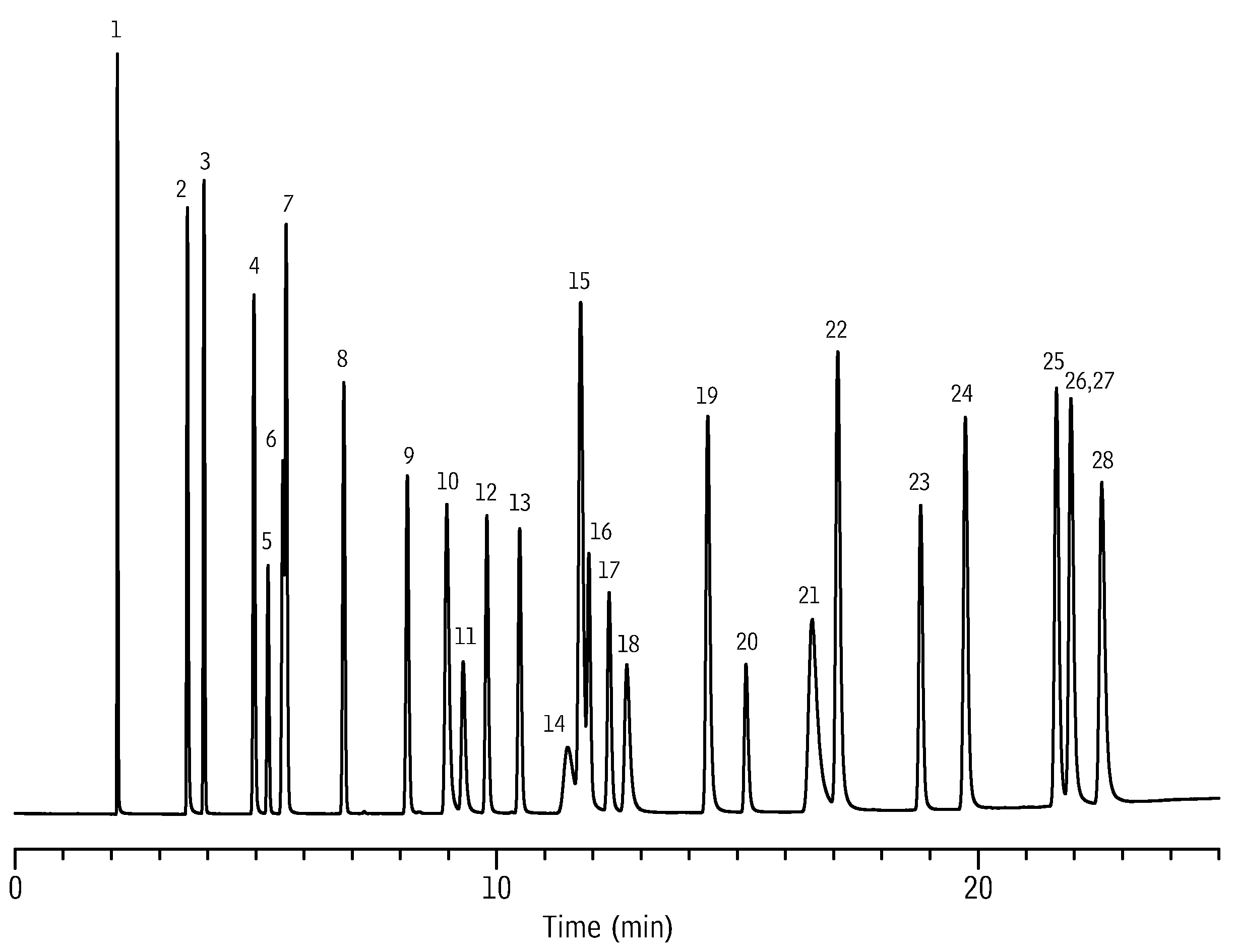
| Peaks | |
|---|---|
| 1. | Methanol |
| 2. | Ethanol |
| 3. | Acetonitrile |
| 4. | Acetone |
| 5. | Dichloromethane |
| 6. | 1,1-Dichloroethene |
| 7. | Nitromethane |
| 8. | trans-1,2-Dichloroethylene |
| 9. | cis-1,2-Dichloroethylene |
| 10. | Tetrahydrofuran |
| 11. | Chloroform |
| 12. | Ethyl acetate |
| 13. | 1,2-Dichloroethane |
| 14. | 1,1,1-Trichloroethane |
| Peaks | |
|---|---|
| 15. | Benzene |
| 16. | 1,2-Dimethoxyethane |
| 17. | Trichloroethylene |
| 18. | 1,4-Dioxane |
| 19. | Pyridine |
| 20. | Dimethylformamide |
| 21. | Methylcyclohexane |
| 22. | Toluene |
| 23. | 2-Hexanone |
| 24. | Chlorobenzene |
| 25. | Ethylbenzene |
| 26. | m-Xylene |
| 27. | p-Xylene |
| 28. | o-Xylene |
| Column | Rt-Q-BOND, 30 m, 0.53 mm ID, 20 µm (cat.# 19742) |
|---|---|
| Standard/Sample | Solvent mixture |
| Injection | |
| Inj. Vol.: | 1.0 µL split |
| Liner: | Splitless taper (4 mm) |
| Inj. Temp.: | 200 °C |
| Split Vent Flow Rate: | 100 ml/min. |
| Oven | |
| Oven Temp.: | 120 °C to 240 °C at 5 °C/min (hold 5.0 min) |
| Carrier Gas | H2, constant pressure (4.2 psi, 29.0 kPa) |
| Linear Velocity: | 40 cm/sec @ 120 °C |
| Detector | FID @ 240 °C |
|---|---|
| Notes | Liner cat.# 20798 was used to produce this chromatogram, but has since been discontinued. For assistance choosing a replacement for this application, contact Restek Technical Service or your local Restek representative. |
Rt-QS-BOND Columns (fused silica PLOT)
porous divinylbenzene homopolymer
- Intermediate polarity porous polymer PLOT column incorporating low 4-vinylpyridine.
- Separates ethane, ethylene, and acetylene to baseline.
- Stable to 250 °C.
Refinery Gas Mixture on Rt-QS-BOND
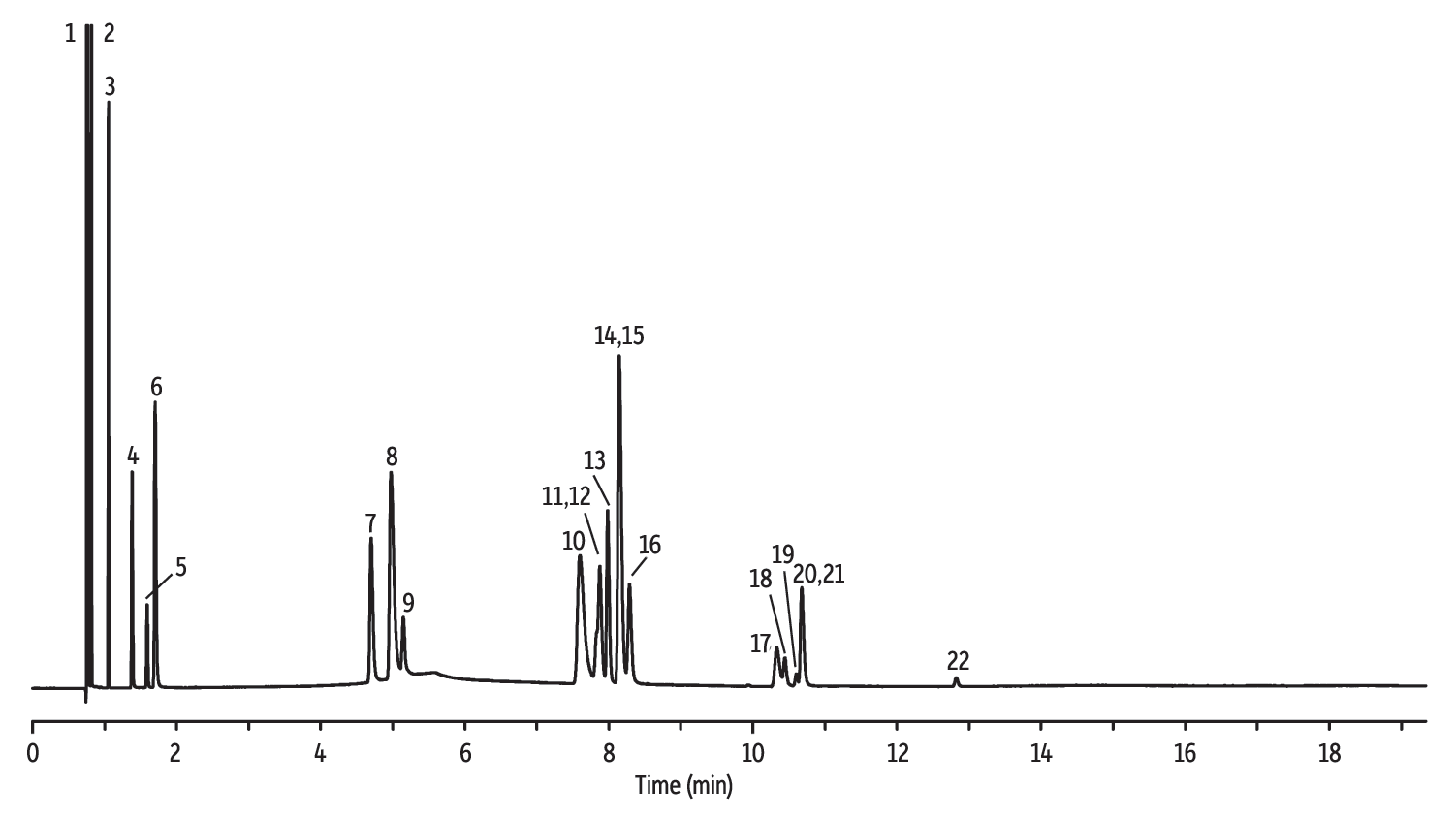
| Peaks | |
|---|---|
| 1. | Air |
| 2. | Methane |
| 3. | Carbon dioxide |
| 4. | Ethylene |
| 5. | Acetylene |
| 6. | Ethane |
| 7. | Propylene |
| 8. | Propane |
| 9. | Propadiene |
| 10. | Isobutane |
| 11. | Isobutylene |
| Peaks | |
|---|---|
| 12. | 1-Butene |
| 13. | 1,3-Butadiene |
| 14. | n-Butane |
| 15. | cis-2-Butene |
| 16. | trans-2-Butene |
| 17. | Isopentane |
| 18. | 1-Pentene |
| 19. | 2-Methyl-2-butene |
| 20. | n-Pentane |
| 21. | cis-2-Pentene |
| 22. | n-Hexane |
| Column | Rt-QS-BOND, 30 m, 0.53 mm ID, 20 µm (cat.# 19738) |
|---|---|
| Standard/Sample | Refinery gas standard |
| Injection | |
| Inj. Vol.: | 20 µL split |
| Liner: | 2.0 mm ID straight inlet liner |
| Inj. Temp.: | 200 °C |
| Split Vent Flow Rate: | 35 mL/min. |
| Oven | |
| Oven Temp.: | 40 °C (hold 2 min) to 225 °C at 15 °C/min (hold 5 min) |
| Carrier Gas | He, constant pressure (11.5 psi, 79.3 kPa) |
| Linear Velocity: | 68 cm/sec @ 40 °C |
| Detector | TCD @ 225 °C |
|---|---|
| Make-up Gas Type: | He |
| Data Rate: | 20 Hz |
| Sensitivity Mode: | He/H2 |
| Instrument | HP5890 GC |
| Notes | GC liner cat.# 20712 was used to produce this chromatogram, but it has since been discontinued. For assistance choosing a liner for this application, contact Restek Technical Service or your local Restek representative. |
Rt-S-BOND Columns (fused silica PLOT)
porous divinylbenzene homopolymer
- Midpolarity porous polymer PLOT column, incorporating high 4-vinylpyridine.
- Use for the analysis of nonpolar and polar compounds.
- Stable to 250 °C.
Solvent Mixture on Rt-S-BOND
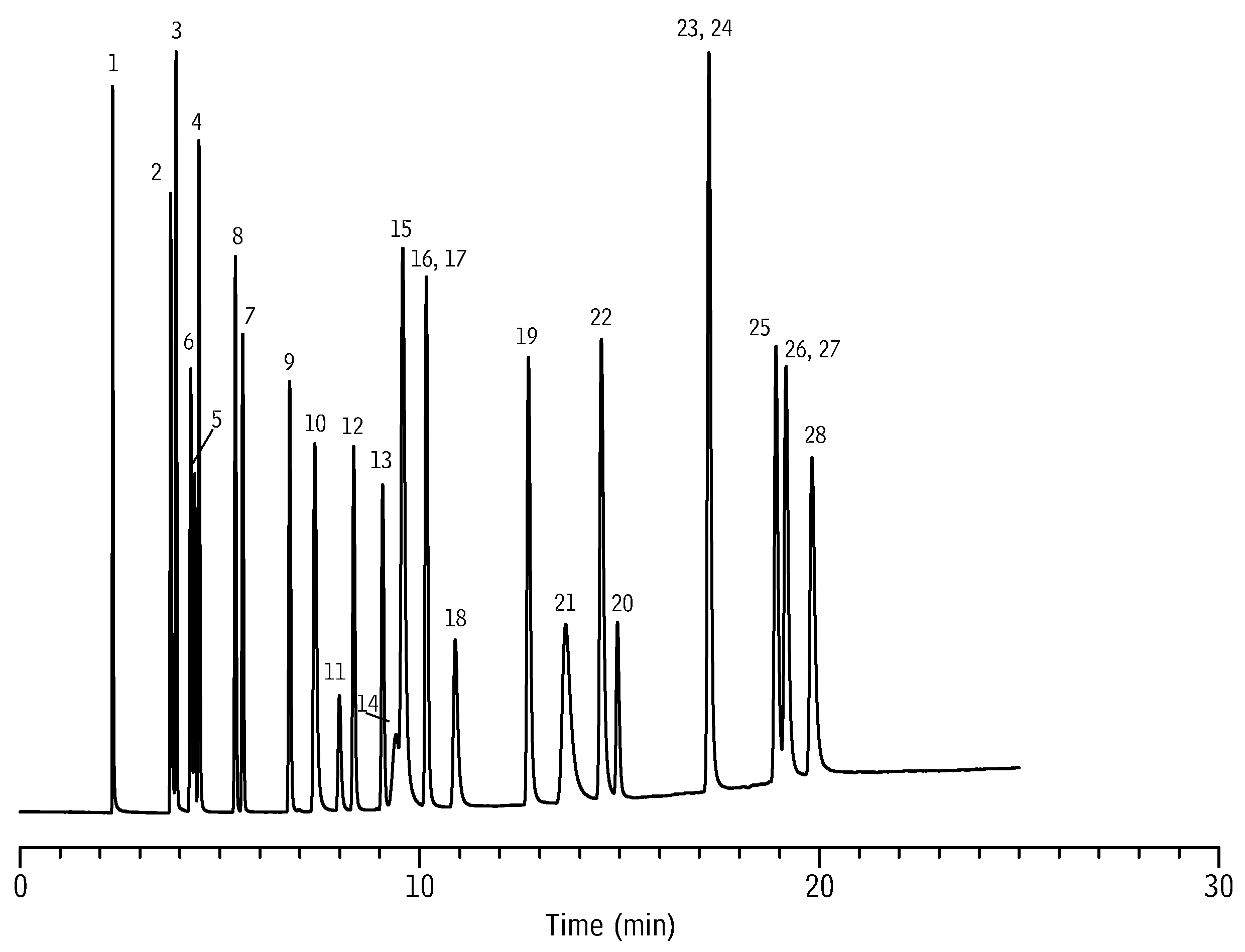
| Peaks | |
|---|---|
| 1. | Methanol |
| 2. | Ethanol |
| 3. | Acetonitrile |
| 4. | Acetone |
| 5. | Dichloromethane |
| 6. | 1,1-Dichloroethene |
| 7. | Nitromethane |
| 8. | trans-1,2-Dichloroethylene |
| 9. | cis-1,2-Dichloroethylene |
| 10. | Tetrahydrofuran |
| 11. | Chloroform |
| 12. | Ethyl acetate |
| 13. | 1,2-Dichloroethane |
| 14. | 1,1,1-Trichloroethane |
| Peaks | |
|---|---|
| 15. | Benzene |
| 16. | 1,2-Dimethoxyethane |
| 17. | Trichloroethylene |
| 18. | 1,4-Dioxane |
| 19. | Pyridine |
| 20. | Dimethylformamide |
| 21. | Methylcyclohexane |
| 22. | Toluene |
| 23. | 2-Hexanone |
| 24. | Chlorobenzene |
| 25. | Ethylbenzene |
| 26. | m-Xylene |
| 27. | p-Xylene |
| 28. | o-Xylene |
| Column | Rt-S-BOND, 30 m, 0.53 mm ID, 20 µm (cat.# 19746) |
|---|---|
| Standard/Sample | Solvent mixture |
| Injection | |
| Inj. Vol.: | 1.0 µL split |
| Liner: | Taper (4 mm) |
| Inj. Temp.: | 200 °C |
| Split Vent Flow Rate: | 100 ml/min. |
| Oven | |
| Oven Temp.: | 120 °C to 220 °C at 5 °C/min (hold 5.0 min) |
| Carrier Gas | H2, constant pressure (4.2 psi, 29.0 kPa) |
| Linear Velocity: | 40 cm/sec @ 120 °C |
| Detector | FID @ 220 °C |
|---|---|
| Notes | Liner cat.# 20798 was used to produce this chromatogram, but has since been discontinued. For assistance choosing a replacement for this application, contact Restek Technical Service or your local Restek representative. |
Rt-U-BOND Columns (fused silica PLOT)
divinylbenzene ethylene glycol/dimethylacrylate
- Restek's highest polarity porous polymer column.
- Polar PLOT column, incorporating divinylbenzene ethylene glycol/dimethylacrylate.
- Highly inert for the analysis of polar and nonpolar compounds.
- Common applications include: H2S, COS, and mercaptans in hydrocarbon streams.
- Stable to 190 °C.
Formaldehyde on Rt-U-BOND
Excellent peak shape for highly polar analytes
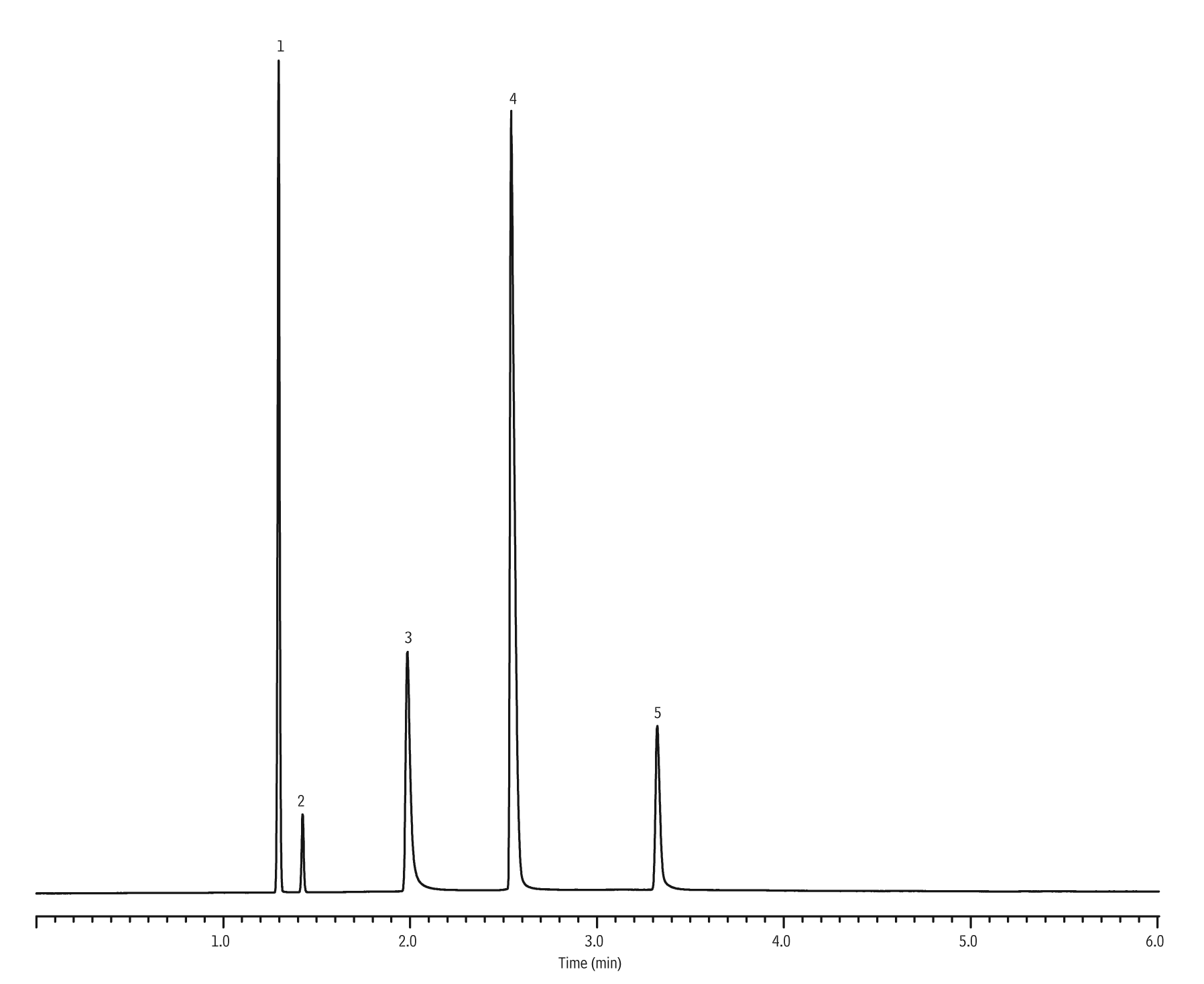
| Peaks | |
|---|---|
| 1. | Air |
| 2. | Carbon dioxide |
| 3. | Formaldehyde |
| 4. | Water |
| 5. | Methanol |
| Column | Rt-U-BOND, 30 m, 0.53 mm ID, 20 µm (cat.# 19750) |
|---|---|
| Standard/Sample | Formaldehyde (manual headspace) |
| Injection | |
| Inj. Vol.: | 10 µL split (split ratio 10:1) |
| Liner: | 2 mm split Precision liner w/wool |
| Inj. Temp.: | 200 °C |
| Split Vent Flow Rate: | 40 mL/min. |
| Oven | |
| Oven Temp.: | 100 °C (hold 1 min) to 150 °C at 25 °C/min (hold 3 min) |
| Carrier Gas | He, constant pressure (7.7 psi, 53.1 kPa) |
| Linear Velocity: | 39 cm/sec @ 100 °C |
| Detector | TCD @ 200 °C |
|---|---|
| Make-up Gas Type: | He |
| Data Rate: | 20 Hz |
| Sensitivity Mode: | He/H2 |
| Instrument | HP5890 GC |
| Sample Preparation | 10 μL of formaldehyde solution added to a 20 mL vial and heated to 60 °C with CO2 added to the headspace. The formaldehyde solution is at a nominal concentration of 37% by weight with 10 to 15% methanol and the remaining amount water to stabilize the formaldehyde. |
| Notes | Liner cat.# 20823 was used to produce this chromatogram, but has since been discontinued. For assistance choosing a replacement for this application, contact Restek Technical Service or your local Restek representative. |
Metal MXT PLOT Columns
Advantages of metal MXT PLOT columns include:
- Can be made in small coil diameters—perfect for tight spaces.
- Rugged material withstands rough handling and shock.
- Designed for robust performance in process GCs and field instruments.
- Available in 3.5"-coil diameter or 7"-diameter, 11-pin cage.
Restek chemists have developed technology that allows many of our popular PLOT columns to be made on Siltek-treated stainless steel. These columns have the same characteristics and performance as fused silica PLOT columns, but offer additional benefits for process GCs and field applications as they are virtually unbreakable and can be coiled into very small diameters.
| MXT-Msieve 5A | MXT-Alumina BOND/MAPD | |
| ORDER NOW | ORDER NOW | |
| MXT-Alumina BOND/Na2SO4 | MXT-Q-BOND | |
| ORDER NOW | ORDER NOW |
MXT Low Dead Volume Connector Kits for Metal Columns
- Connect a guard column/transfer line to an MXT stainless steel column.
- Low thermal mass tracks rapid oven temperature programming.
- Stainless-steel ferrules and nuts.
- Available in “Y” and union configurations.
- Siltek treatment ensures ultimate inertness.
Each kit contains the MXT union, two 1/32-inch ferrules and nuts.

